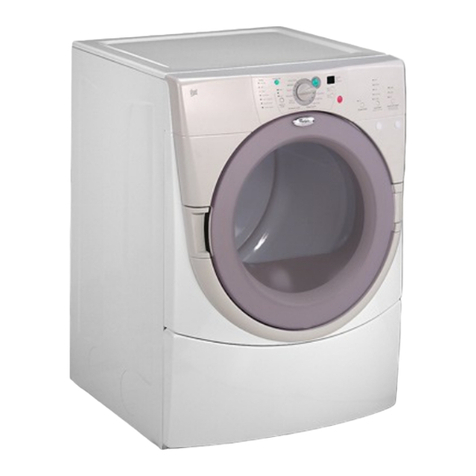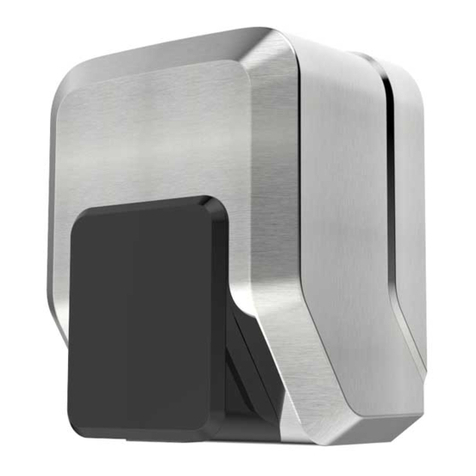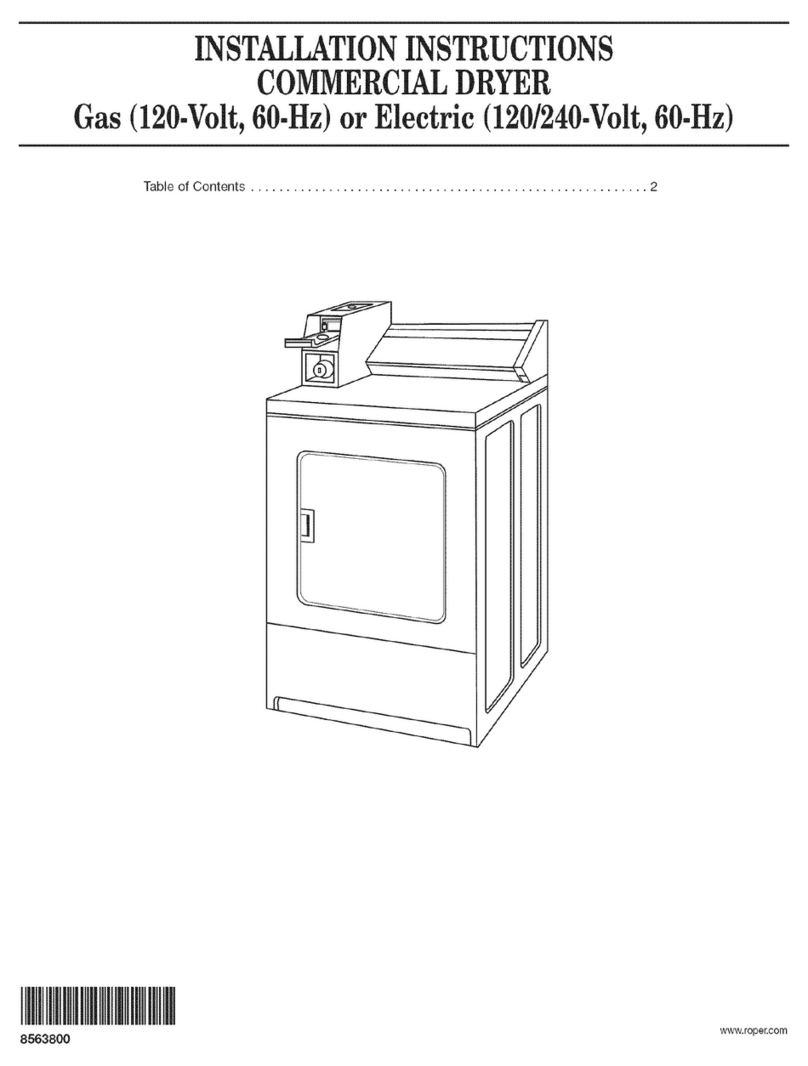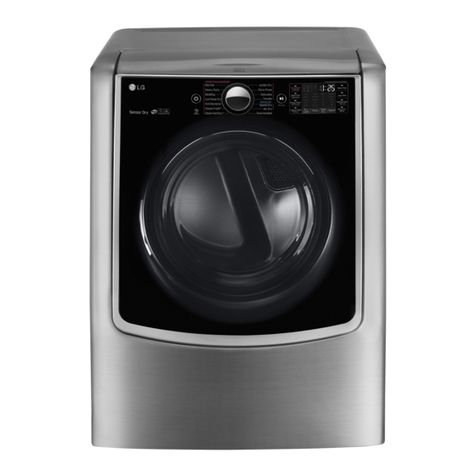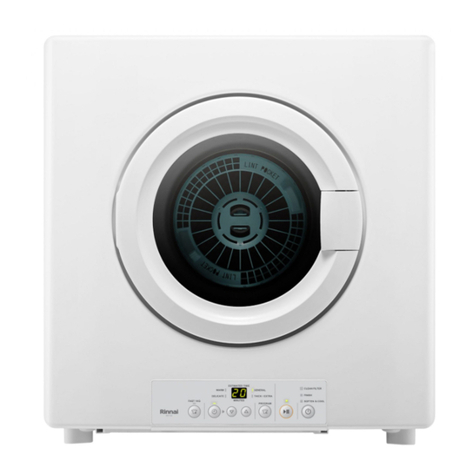St George LEG37A*F4350 User manual

D310IE3B
Use and Care Guide and Warranty
Automatic Clothes Dryer
Full Five Year Warranty
Parts & Labour
LEG37A*F4350
LGG37A*F3058
KEEP THESE INSTRUCTIONS FOR FUTURE REFERENCE. (If the dryer changes ownership, be sure this manual
accompanies the dryer.)
Part No. 510906
August 1999

510906
Table of
Contents
Important Safety Instructions..............................................................3
Before Drying.........................................................................................5
Energy Saving Tips...........................................................................5
Helps and Hints ................................................................................5
Sort ...................................................................................................6
Load..................................................................................................6
Operating Instructions ........................................................................7
Drying Special Items.............................................................................9
User-Maintenance ...............................................................................12
Care Of Your Dryer ........................................................................12
Motor Overload Protector..................................................................12
Lint Filter.............................................................................................13
Before You Call For Service...............................................................14
If Service Is Required .........................................................................15
Automatic Dryer Warranty...................................... Inside Back Cover
Information For Handy Reference..................................... Back Cover
FOR YOUR SAFETY, the information in this manual must be
followed to minimize the risk of fire or explosion or to prevent
property damage, personal injury or death. W033
• Do not store or use gasoline or other flammable vapors and
liquids in the vicinity of this or any other appliance.
• WHAT TO DO IF YOU SMELL GAS:
– Do not try to light any appliance.
– Do not touch any electrical switch; do not use any phone in
your building.
– Clear the room, building or area of all occupants.
– Immediately call your gas supplier from a neighbor’s
phone. Follow the gas supplier’s instructions.
– If you cannot reach your gas supplier, call the fire
department.
• Installation and service must be performed by a qualified
installer, service agency or the gas supplier. W052
WARNING
©Copyright 1999, Alliance Laundry Systems LLC
All rights reserved. No part of the contents of this book may be reproduced or transmitted in any form or by any means
without the expressed written consent of the publisher.

510906 3
IMPORTANT SAFETY INSTRUCTIONS
(Save These Instructions)
1. Read all instructions before using the dryer.
2. Refer to theEARTHING INSTRUCTIONS in the
INSTALLATION manual for the proper earthing
of the dryer.
3. Do not dry articles that have been previously
cleaned in, soaked in, washed in, or spotted with
gasoline, dry-cleaning solvents, other flammable
or explosive substances as they give off vapors
that could ignite or explode.
4. Do not allow children to play on or in the dryer.
Close supervision of children is necessary when
the dryer is used near children. This is a safety
rule for all appliances.
5. Before the dryer is removed from service or
discarded, remove the door to the drying
compartment.
6. Do not reach into the dryer if the cylinder is
revolving.
7. Do not install or store the dryer where it will be
exposed to the water and/or weather.
8. Do not tamper with the controls.
9. Do not repair or replace any part of the dryer, or
attempt any servicing unless specifically
recommended in the User-Maintenance
Instructions or in published user-repair
instructions that you understand and have the
skills to carry out.
10. Do not use fabric softeners or products to
eliminate static unless recommended by the
manufacturer of the fabric softener or product.
11. To reduce the risk of fire, DO NOT DRY plastics
or articles containing foam rubber or similarly
textured rubberlike materials.
12. Always clean the lint filter after every load. A
layer of lint in the filter reduces drying efficiency
and prolongs drying time.
13. Keep area around the exhaust opening and
adjacent surrounding area free from the
accumulation of lint, dust and dirt.
14. The interior of the dryer and the exhaust duct
shouldbecleanedperiodicallybyqualifiedservice
personnel.
15. This gas appliance contains or produces a
chemical or chemicals which can cause death or
seriousillnessand whichareknowntotheStateof
California to cause cancer, birth defects, or other
reproductive harm. To reduce the risk from
substances in the fuel or from fuel combustion,
make sure this appliance is installed, operated,
and maintained according to the manufacturer’s
instructions.
16. Dryerwillnot operatewiththe loading dooropen.
DO NOT by-pass the door safety switch by
permitting the dryer to operate with the door
open. The dryer will stop tumbling when the door
is opened. Do not use the dryer if it does not stop
tumbling when the door is opened or starts
tumbling without pressing or turning the START
mechanism. Remove the dryer from use and call
the serviceman.
17. Do not put articles soiled with vegetable or
cooking oil in the dryer, as these oils may not be
removed during washing. Due to the remaining
oil, the fabric may catch on fire by itself.
To reduce the risk of fire, electric shock,
serious injury or death to persons when
using your dryer, follow these basic
precautions: W130
WARNING

4510906
18. To reduce the risk of fire, DO NOT put clothes
which have traces of any flammable substances
such as machine oil, flammable chemicals,
thinner, etc. or anything containing wax or
chemicals such as in mops and cleaning cloths, or
anything dry- cleaned at home with dry-cleaning
solvent in the dryer.
19. Use the dryer only for its intended purpose,
drying clothes.
20. Always disconnect the electrical power to the
dryer before attempting service. Disconnect the
power cord by grasping the plug, not the cord.
21. If the supply cord is damaged, it must be replaced
by a special cord or assembly available from the
manufacturer or its service agent.
22. Install this dryer according to the
INSTALLATION INSTRUCTIONS. All
connections for electrical power, earthing and gas
supply must comply with local codes and be made
by licensed personnel when required. Do not do it
yourself unless you know how!
23. Remove laundry immediately after the dryer
stops.
24. Always read and follow manufacturer’s
instructions on packages of laundry and cleaning
aids. Heed all warnings or precautions. To reduce
the risk of poisoning or chemical burns, keep
them out of reach of children at all times
(preferably in a locked cabinet).
25. Do not tumble fibreglass curtains and draperies
unless the label says it can be done. Iftheyare
dried, wipe out the cylinder with a damp cloth to
remove particles of fibreglass.
26. ALWAYS follow the fabric care instructions
supplied by the garment manufacturer.
27. Never operate the dryer with any guards and/or
panels removed.
28. DO NOT operate the dryer with missing or
broken parts.
29. DO NOT by-pass any safety devices.
30. Failure to install, maintain, and/or operate this
machine according to the manufacturer’s
instructions may result in conditions which can
produce bodily injury and/or property damage.
NOTE: The WARNING AND IMPORTANT
SAFETY INSTRUCTIONS appearingin this manual
are not meant to cover all possible conditions and
situations that may occur. Common sense, caution
and care must be exercised when installing,
maintaining, or operating the dryer.
Always contact your dealer, distributor, service agent or
the manufacturer about any problems or conditions you
do not understand.

510906 5
Before Drying . . .
Energy Saving Tips
• Make sure the lint filter is always clean.
• Do not overload the dryer.
• Do not overdry items.
• Remove items to be ironed while still damp.
• Large loads of similar fabrics dry the most efficiently.
However, dry permanent press in smaller loads to
prevent wrinkling.
• Use the correct cycle for the type of fabric being dried.
• Locate your dryer so the exhaust duct is as short and
straight as possible.
• Do not open the door during the drying cycle.
• Plan to do your laundry on low humidity days; your
clothes will dry faster.
• Dry multiple loads of clothes one right after another so
dryer interior does not have to be reheated for each
load.
Helps and Hints
• The necessary suggestions and directions for
installation and proper exhausting are given in
the INSTALLATION INSTRUCTIONS which are
included with the dryer.
• Static electricity may cause garments of synthetic
fibres (as in lingerie) to cling together, especially if
they are overdried. The use of a liquid fabric softener
in the rinse water of the washer, or a fabric softener
sheet in the dryer, will soften clothes and reduce static
electricity.
• Do not wash or dry clothes that shed lint in the same
load with permanent press or knit garments.
• Remove permanent press loads immediately after
dryer stops.
• Follow the CARE LABELS on FLAME
RETARDANT, SCOTCH- GUARD™, etc., garments
for the proper washing and drying.
• If loads should be damp for ironing, turn timer knob to
the ENERGY SAVER setting, marked with a dot (•),
in Automatic or Time Dry cycles.
To reduce the risk of fire, explosion,
serious injury or death, clothes which have
traces of any flammable substances such
as cooking oil, machine oil, flammable
chemicals, thinner, etc. must not be put
into the dryer. W131
WARNING

6510906
Sort
If you have correctly sorted the items for washing, they
should be properly sorted for drying too.
Towels, flannels, chenille, cottons, rugs, etc., shed lint.
Corduroys, knits (including socks), permanent press, and
synthetics attract lint.
In any kind of drying, lightweight fabrics will dry faster
than heavyweight fabrics. If mixed loads are dried
together (such as sheets and towels), remove the lighter
weight fabrics when they are dry to prevent overdrying
and wrinkling. The best method is to dry clothes which
require the same time and temperature in the same load.
Load
Do not overload your dryer. Bulk, not weight, determines
the load size. If the dryer is overloaded, it could cause
discoloration or permanent heat damage to the load.
There should be space in the dryer for the clothes to
tumble freely. This helps to reduce wrinkles. Large and
small pieces together make up loads which will tumble
well. Permanent press loads should be smaller to provide
room for tumbling. Proper tumbling allows for fewer
wrinkles. The following illustrationsshow the ideal loads
sizes for fabrics. The average load will fill the cylinder
one third to half full when wet.
A load can be too small. Just a few small pieces will not
tumble properly. They will take longer to dry and they
may be wrinkled. For small loads, add a couple of large
towels or non lint shedding items to aid in tumbling.
Separate: Lights
Darks
Separate: Lint Shedding
Fabric
Lint Receiving
Fabric
Separate: No Heat Items
Low Heat Items
High Heat Items
D665IE0A
D666IE0A
Cylinder with wet
permanent press
Cylinder with wet
cottens and linens

510906 7
D667IE0A
Operating Instructions . . .
Available Drying Cycles
NOTE: Use the automatic cycles for drying items that
canbedriedwithheat.Thesecycles automaticallydry
loads to the dryness level selected.
MORE DRY will dry very small loads and some heavy
items, such as blue jeans, but will overdry lightweight
items, such as sheets and shirts. Overdrying can cause
wrinkling, shrinking, excessive lint conditions, and will
use more energy than necessary.
LESS DRY, which uses the least energy, will dry large
loads and lightweight items, such as sheets and shirts, but
might leave other items, such as denim and heavy bath
towels, more damp.
To increase energy savings and to make sure loads are
dried without overdrying, set yourloads onLESS DRY. If
itemsare damp atthe end of a cycle, the timer knob needs
to be set closer to the MORE DRY setting the next time
these loads are dried. If items are overdry at the end of a
cycle, the timer knob should be set closer to DELICATE
or COOL TUMBLE when these loads are dried again.
Remember the settings that work best to get ideal drying
results.
DELICATE, available only in the AUTOMATIC
REGULAR/DELICATE cycle, will dry sheer items and
very lightweight cottons, but will leave heavier items
damp. If items are damp at the end of the cycle, set the
timer knob closer to the LESS DRY setting the next time
these loads are dried. If items are overdry at the end ofthe
cycle, the timer knob should be set closer to COOL
DOWN.
The COOL DOWN and COOL TUMBLE period at the
end of each cycle provides items a chance to tumble with
no heat and cool down to room temperature. This
prevents wrinkles from setting if items cannot be cared
for immediately.
NOTE: The timer knob will not advance as quickly in
the AUTOMATIC cycles as it does in the TIME DRY
cycle. The time it takes for the timer to advance
depends on the type and size of the load being dried.
Automatic Regular/Delicate Cycle
Useforsturdyitemslike playor workclothesand alsofor
delicate items. The type of heat is determined by
choosing the proper Fabric Selector option. There are
three settings in the AUTOMATIC REGULAR/
DELICATE cycle— MORE DRY, LESS DRY, and
DELICATE.
Time Dry Cycle
This cycle will operate dryer for up to 80 minutes.
Cottons and heavyweight items dry best between 50 and
70 minutes, and lightweight items dry best between 20
and 40 minutes.
Automatic Permanent Press/Knits Cycle
Useforpermanentpressitemsandsynthetics.Thetypeof
heat is determined by selecting the proper Fabric
Selector option (see following page). There are two
settings in the AUTOMATIC PERMANENT PRESS/
KNITS cycle—MORE DRY, and LESS DRY.
To Dry Clothes
IMPORTANT: See the INSTALLATION
INSTRUCTIONS before using dryer.
IMPORTANT: Before using dryer for the first time,
use an all purpose cleaner, or a detergent and water
solution, and a damp cloth to remove shipping dust
from inside dryer drum.
1. Sort items into separate loads.
2. Remove lint filter cover,
cleanlintfilterandreplace
cover before each use.
To reduce the risk of fire, electric shock,
serious injury or death to persons, read the
IMPORTANT SAFETY INSTRUCTIONS on
pages 4–5 before operating the dryer. W128-2
WARNING
D305IE1A

8510906
FABRIC SELECTOR
DELICATE REGULAR
PERM PRESS
AIR FLUFF
NO HEAT
CPD111
SIGNAL
OFF LOUD
CPD111A
D666IE0A
D668IE0A
D660I
3. Add clothes loosely into
dryer drum. Add fabric
softener sheet, if desired.
4. Close loading door.
Dryer will not operate
with the door open.
5. Select FABRIC SELECTOR. Follow garment
manufacturer’s care labels for recommended
temperature settings.
6. Select
timer setting in cycle desired: AUTOMATIC
REGULAR/DELICATE, TIME DRY, and
AUTOMATIC PERMANENT PRESS/KNITS.
These cycles control the drying time.
7. Push timer knob in to start dryer.
NOTE: To stop dryer at any time, open the door or
turntimer knobto anOFF position. Torestartdryer,
close door, reset timer if necessary, and push in the
timer knob.
End of Cycle Signal
The volume of the signal tone may be set on OFF, LOUD
or between the two selections. If a volume level is
selected, the signal will let you know when the cycle is
done. The signal will stop when the door is opened, or
when the timer is advanced to an OFF position.
Drying Rack
The drying rack is useful for items that require no-tumble
drying, such as tennis shoes, sweaters, stuffed toys or
other delicate items.
The rack can be installed by inserting drying rack
mounting into the two (2) round holes in door. See the
illustration below.

510906 9
Drying Special Items . . .
Type of Load Special Instructions
Bedspreads Choose heat for fabric. Dry one double or two single spreads. Chenille and
tufted spreads will shed lint and should be dried by themselves. New spreads
especially, will contain loose lint. Tumble on NO HEAT setting before washing
to remove loose lint. These spreads may be dried completely.
Blankets
Electric
Synthetic Fibres
Thermal Cotton
Wool
DELICATE or NO HEAT cycles. If drying items in dryer is recommended by
the manufacturer, dry as for wool. Do not stretch the blanket because of the
wiring. Some electric blankets may have an insulation on the the thermostats or
on the wiring which will not withstand dryer heat. Do not dryer dry unless the
blanket manufacturer says it can be done.
DELICATE or NOHEAT cycles. Someof these blankets are fluffy andwill shed
lint. Tumble on NO HEAT setting before washing to remove loose lint. Use a
gentle wash method, then dry in dryer until just dry. The lint filter may need to
be cleaned during the drying.
AUTOMATIC REGULAR cycle.
Agitation and tumbling contribute to the shrinkage and felting of wool. We
cannot guarantee that wool will not shrink. However, if care is taken and the
blanket manufacturer’s instructions are followed, satisfactory results should be
obtained. Wash by the soak method with as little agitation as possible. After
washing, stretch blanket gently in both directions. Use approximately five dry
bath towels and place them between folds in blanket. This will “cushion” it to
lessen the tumbling. Set dryer for 20 minutes on the TIME DRY cycle. Use
REGULAR heat setting, if it is available on your dryer. Check blanket when
timer reaches 10. Wool blankets must be removed from the dryer when damp.
Stretch gently to shape and finish drying over two clothes lines or in a flat
position.
Curtains
Cotton
Fibreglass
Synthetic Fibres
AUTOMATIC REGULAR or TIME DRY cycles. Remove damp items for
ironing or dry completely, then steam iron.
DO NOT DRY IN THE DRYER unless recommended by the manufacturer.
Fibreglass may shred. Particles may remain in the dryer and rub off on the next
load. This could irritate the skin. “Beta” fibreglass may be dryer dried if
recommended by the manufacturer.
DELICATE orNO HEAT cycles. Allow room fortumbling toprevent wrinkling.
Delicate or sheer curtains must be dried by themselves so they will not be
snagged by hooks or crushed by other clothes in the load. Some sheer curtains
are heat sensitive. Dry 10 minutes only, plus the cool down period. Remove from
dryer immediately and hang. If the dryer has been heated from a previous load,
NO HEAT setting may be sufficient.
Denim, Corduroy AUTOMATIC REGULAR cycle. Dry completely and remove from dryer when
seams are slightly wet to minimize shrinkage.

10 510906
Draperies Remove hooks and weights before washing. Choose heat for fabric and allow
space in the dryer for tumbling. Some draperies may be removed when slightly
damp and hung immediately. Lined draperies should be dry-cleaned because
they have a tendency to pucker.
Knit Articles
Cottons
Synthetic Fibres
Wool
Knit fabrics are usually manufactured under tension (stretching). Cotton knits
especially may relax or draw together if every bit of moisture is removed from
them. It is best to take them out of the dryer with a trace of moisture remaining,
then stretch to shape. If they do shrink from overdrying, rewet them and dry
properly.
AUTOMATIC REGULAR or TIME DRY cycle. Remove slightly damp to
minimize ironing. Reshape, smooth seams and pockets, etc.
AUTOMATIC REGULAR or AUTOMATIC PERMANENT PRESS cycle.
Turn inside out to prevent “pilling” (the rolling up of the fibre ends from
friction). Dry sweaters only with similar things because they tend to attract lint.
Make sure the load is large enough for tumbling. Dry completely and remove
from dryer immediately to minimize wrinkling.
DELICATE or NO HEAT cycle. For wool labeled “machine washable”, follow
manufacturer’s directions. For other wool, use wool blanket method. Do not
dryer dry loosely knit wool or hand knits. Dry these flat and stretch to shape
from a pattern drawn before washing.
Lingerie
Cotton
Elastic
Foam Rubber
Spandex
Stretch Fabrics
Synthetic Fibres
AUTOMATIC REGULAR cycle.
Body oils can cause elastic to deteriorate. Wash garments containing elastic
frequently. Elastic in such things as shorts may be dried as for fabric, but avoid
overdrying.
Bras, bathing suits, sun suits, etc. DO NOT DRY THESE ITEMS IN THE
DRYER WITH HEAT, FIRE MAY RESULT. NO HEAT setting may be used.
Most girdles (control briefs or shapers) today are made from Spandex. Use
DELICATE or NO HEAT cycles. Do not overdry.
Choose heat for the most delicate fibre. These may be dried completely as they
will stretch into shape. Avoid drying with lint-shedding fabrics.
TIME DRY cycle. Use a DELICATE or LOW HEAT setting, if it is available.
Some sheer fabrics, especially sheer knits, can be heat sensitive. Dry these until
they are just dry (about 10 minutes) and remove from dryer immediately. Sheer
fabrics should not be washed and dried with garments containing hooks or
zippers. Man-made fabrics will create static electricity if overdried. To prevent
this, use fabric softener and avoid overdrying.
Mattress Pads The materials in mattress pads is made of either cotton or synthetic fibres. Read
the fibre content label, found on your mattress pad, to determine what type of
fibre was used to manufacture the pad. READ AND CAREFULLY FOLLOW
the fabric care instructions supplied by the mattress pad manufacturer. Some
pads made of synthetic fibres are very heat sensitive. These pads can be
flammable if over-heated or over-dried. TO AVOID A FIRE HAZARD, DO
NOT OVER-DRY mattress pads. Remove pads from the dryer while they are
still damp.
Type of Load Special Instructions

510906 11
Pillows
Feather and Down-Filled
Fibre-Filled (polyester)
Foam Rubber
Ticking must be strong and seams secure. If in doubt, sew pillow into a case or
use a zippered pillowcase to prevent feathers from coming out. After washing,
shake pillow to fluff feathers. Dry one large or two smaller pillows. Use TIME
DRY cycle. Use LOW or MEDIUM heat setting if it is available on your dryer.
Shake and reposition pillows several times during drying. Pillows must be dry
in the center to prevent mildew. Drying may take two hours or longer. Reset
dryer timer if necessary. The odor of wet feathers is not pleasant. However, the
odor will disappear once the pillows dry.
Follow manufacturer’s directions.
Do not dry in the dryer.
Quilts Choose heat and cycle for fabric. Filling and cover must be completely
washable. Old quilts may be too fragile to machine wash or dry. Quilts filled
withcottonmay becomelumpy.Quiltingshouldbe closetogether. Removefrom
dryer slightly damp and stretch gently to shape. Quilted articles may shrink if
overdried.
Rugs
Cotton With Cotton Backing
Rubber-backed
Synthetic Fibres
AUTOMATIC REGULAR or TIME DRY cycles. Dry one large or several small
rugs. For one small rug only, add towels for buffers.
Hot water and heat tend to deteriorate many types of rubber. Some types of
rubber-like materials are flammable under certain conditions. DO NOT DRY
FOAM RUBBER AND RUBBER-LIKE MATERIALS WITH HEAT.
DELICATE or NO HEAT cycles. Follow manufacturer’s suggestions. Some of
these rugs are heat sensitive and should be removed from the dryer when damp,
or dried with no heat.
Slip Covers Choose heat for fabric. Close zippers. Dry one couch cover, two chair covers or
five or six pillow covers at one time. Remove from dryer when slightly damp.
Press pleats if necessary and replace on furniture immediately. Stretch fabrics
and knits should be dried completely so they will fit snug when replaced on
furniture.
Stuffed Animals and Toys Make sure the filling and covering are washable and can be dryer dried. Cotton
filling may become lumpy. Protect glass eyes by covering with a stocking or tie
toy into a pillowcase. Choose heat for most sensitive fibre. Dry enough clothes
in the load for good tumbling. DO NOT DRY TOYS STUFFED WITH FOAM
RUBBER OR KAPOK IN THE DRYER WITH HEAT.
Tennis Shoes DELICATE or NO HEAT cycle. Use a drying rack or tumble with at least four
old bath towels.
Type of Load Special Instructions

12 510906
User-Maintenance . . .
Care Of Your Dryer
Dryer Interior
Unstable dyes used in many denim blue jeans or brightly
coloured cottongarmentsmaycausesomediscolouration
of the interior surfaces. This slight colour change will do
no harm to other clothes.
Should you wish to return the interior surfaces to their
original whiteness follow the directions below.
The dryer may be cleaned by one of the following
methods:
• Wipe the surfaces using a soft clothand a non-abrasive
paste of powdered laundry detergent and hot water
followed by a short heat cycle with a load of rags, or
• Apply a liquid spray household cleaner to a soft cloth,
wipe the discoloured area and follow with a short heat
cycle with a load of rags.
To remove crayon or ball point inkoffthe dryer drum, put
the heat on high and use old rags in the dryer to absorb
the crayon or ink. If unsuccessful, contact the appliance
dealer. DO NOT use any chemicals in the dryer.
IMPORTANT: The use of chlorine bleach for
removing any discolourations should be avoided
because bleach could damage the finish.
Cabinet
Wipe dryer cabinet as needed. If detergent, bleach or
other washing products have been spilled on the dryer
top, wipe immediately. Some products will cause
permanent damage if spilled on the cabinet.
Do not lay sharp or rough objects on or against the dryer.
The finish could be damaged.
Control Panel
Use only a damp or sudsy cloth for cleaning the control
panel. Some spray prewash products may harm the finish
on the control panel.
Exhaust System
• Keep dryer area clear and free from combustible
materials, gasoline, and other flammable vapours and
liquids. Do not obstruct the flow of ventilation air.
• The exhaust duct should be inspected after one year of
use and cleaned if necessary. Inspect and clean
exhaust duct every one to two years as required
thereafter.
• Vent hood should be checked and cleaned regularly to
assure that it is working properly.
NOTE: Verify proper operation after servicing.
Motor Overload Protector . . .
The dryer’s motor overload protector stops the motor
automatically in the event of an overload. After cooling,
the overload protector will reset itself. Dryer can be
restarted by pushing the timer knob in. If overload
protectorcyclesagain,remove thedryerfrom useandcall
the service person to correct the problem.
To reduce the risk of an electric shock,
serious injury or death, disconnect the
electrical service to the dryer before
cleaning the interior. W132
WARNING

510906 13
amadF
The lint filter is located at the front of the dryer in the
lower part of the door opening.
CLEAN THE LINT FILTER BEFORE DRYING EACH
LOAD.
Remove lint filter cover, clean lint filter and replace
cover. Annually remove lint filter and screw to vacuum
the duct under it.
IMPORTANT: The lint filter must be in place in the
door opening when using dryer or loading and
unloading dryer. If the filter is not in place, clothing
could fall into the front air duct and get into the
exhaust system, causing damage to the motor.
D667IE1A
LINT
FILTER

14 510906
Before You Call For Service . . .
(You may save time and money by checking the following:)
If Your Dryer:
Won’t Start Won’t Heat Doesn’t Dry
Clothes
Satisfactorily Possible Reason — Do This To Correct
•Be sure the power cord is plugged all the way into the electrical
outlet.
•Close the loading door.
•Be sure timer is not in COOL DOWN setting or NO HEAT cycle.
•Push timer knob in to start dryer.
•• Has the laundry room fuse(s) blown or become loosened, or are
circuit breakers open? The dryer itself does not have an electrical
fuse. An electric dryer has an electrical circuit with two fuses.
•Has the motor overload protector cycled? Wait 10 minutes and try
again.
•Is the timer in a heat setting?
•Gas Dryer Only — Check to see if equipment and main gas line
valve is turned on.
••
Check exhaust duct to outside to see if it is kinked, blocked or
needs cleaning.
••
Check weather hood to make sure flapper moves freely, has not
been pushed in or has not been blocked.
•Automatic Cycle — Adjust to more or less dry setting.
•Timed Cycle — Allow more or less time.
•Clean the lint filter.
•Is the load too small? Small loads may not tumble properly or dry
evenly.

510906 15
D674I
If Service Is Required . . .
If service is required, contact StGeorge Customer Care
Centre on FREECALL 1-800-072-144.
StGeorge
P.O. Box 5560
Maroochydore South QLD 4558
or Phone FREECALL
1-800-072-144
When calling or writing about your dryer, PLEASE
GIVE THE MODEL AND SERIAL NUMBERS. The
model and serial numbers are located in one of the four
corners of the door well. The door well is the shaded area
shown.
Please include a copy of your bill of sale and any service
receipts you have.
To reduce the risk of serious injury or death,
DO NOT repair or replace any part of the
dryer or attempt any servicing unless
specifically recommended in the user-
maintenance instructions or in published
user-repair instructions that you understand
and have the skills to carry out. W133
WARNING

16 510906

510906 17

18 510906

510906
Automatic Dryer Warranty . . .
Domestic Warranty
Full Five Year Warranty
In addition to all statutory rights which you, the
Consumer, have under all the relevant laws in respect of
thisappliance, during yourfirst fiveyears ofownershipas
the original purchaser of the StGeorge dryer, we
guarantee that any fault caused by faulty material or
workmanship,becomingapparentwillbe rectifiedfreeof
charge for parts or labour provided that all service is
performed during normal working hours by StGeorge or
their designated Agent. Where the dryer is installed
outside the normal servicing area of the above, the
Purchaser must pay the cost of transporting the appliance
to and from the Agent or the Agentís travelling cost to
and from the Purchaserís home.
Commercial Warranty
Full One Year Warranty
In addition to all statutory rights which you, the
Consumer, have under all the relevant laws in respect of
this appliance, during your first one year of ownership as
the purchaser of the StGeorge dryer, we guarantee that
any fault caused by faulty material or workmanship
becoming apparent will be rectified free of charge for
parts or labour provided that all service is performed
during normal working hours by StGeorge or their
designatedAgent.Wherethedryerisinstalledoutsidethe
normal servicing area of the above, the Purchaser must
pay the cost of transporting the applianceto and from the
Agent or the Agentís travelling cost to and from the
Purchaserís home.
What These Warranties Do Not Cover
We are not responsible for any damage or malfunction
unless caused by a defect in material or workmanship.
This includes, but is not limited to, abuse, misuse,
improper installation, and transportation damage.We are
not responsible for any consequential damages resulting
from any malfunction.

510906
Information For Handy Reference . . .
StGeorge
P.O. Box 5560
Maroochydore South QLD 4558
Date Purchased
Model Number Serial Number
Store Name
Store Address Phone Number
Service Agency
Service Agency Address Phone Number
NOTE: Record this information and keep your sales slip. Model and serial numbers are located
on the nameplate.
Customer Care Centre and
Information Freecall:
1-800-072-144
This manual suits for next models
1
Table of contents
Popular Dryer manuals by other brands
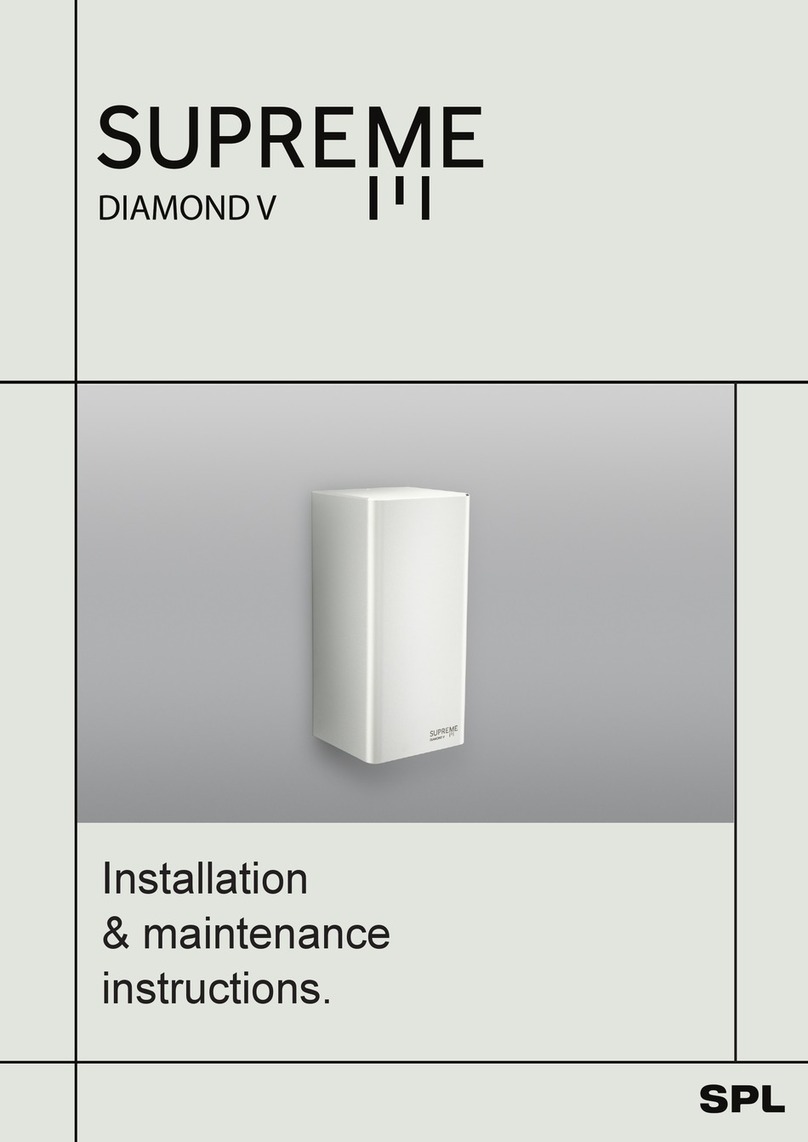
SPL
SPL SUPREME DIAMOND V Installation & maintenance instructions

Maytag
Maytag NGD7200TW technical information
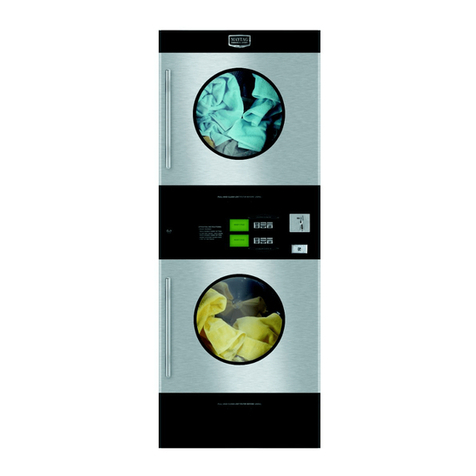
Maytag
Maytag MLG35 installation manual
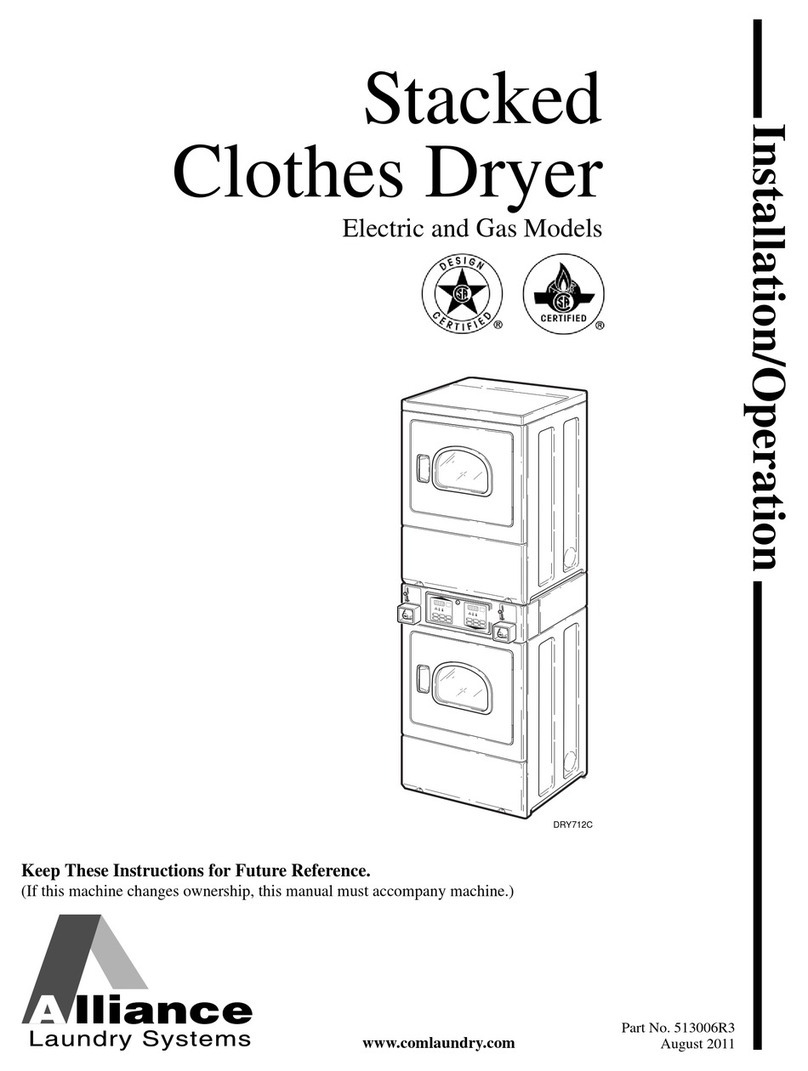
Alliance Laundry Systems
Alliance Laundry Systems 513006R3 Installation & operation
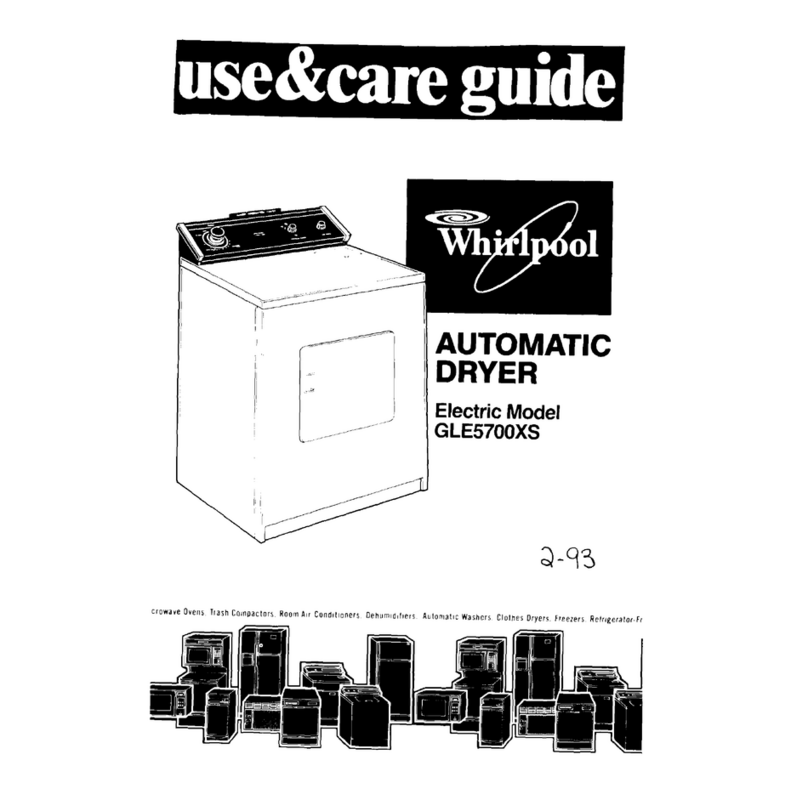
Whirlpool
Whirlpool GLE5700XS Use and care guide
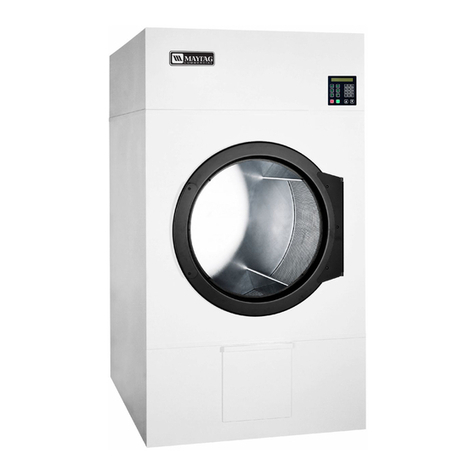
Maytag
Maytag MDG120PHVW installation manual
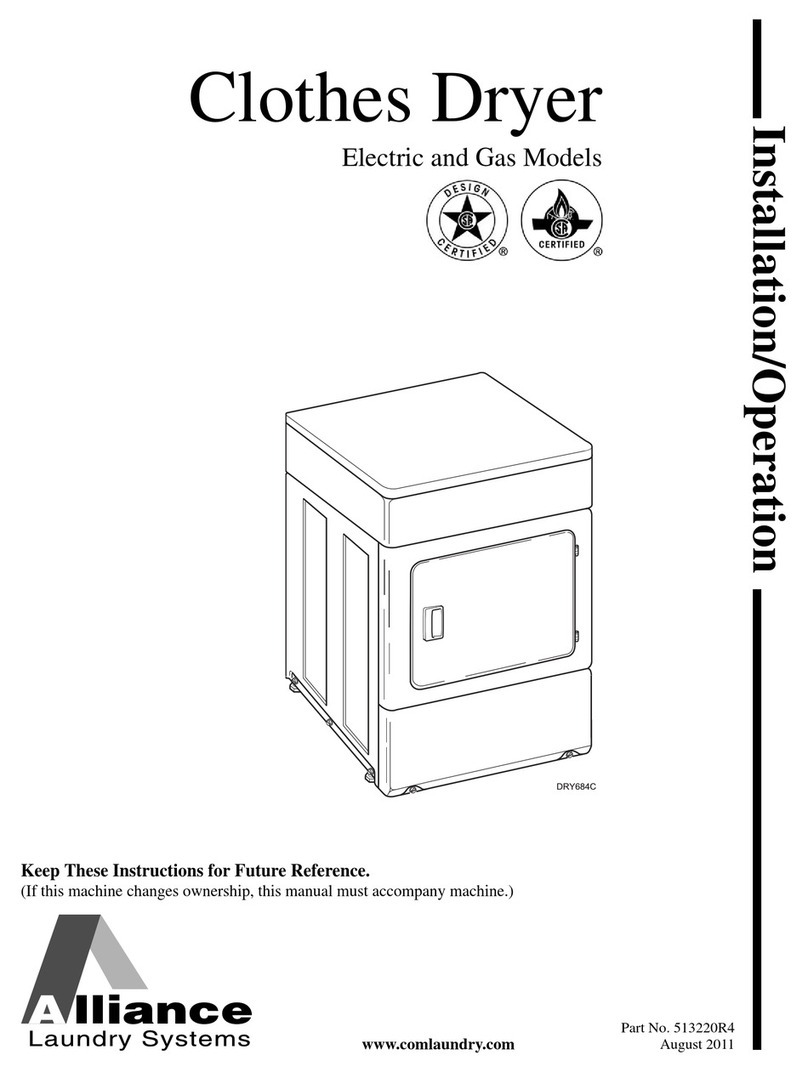
Alliance Laundry Systems
Alliance Laundry Systems DRY684C Installation & operation

DCS
DCS CACTUS installation guide
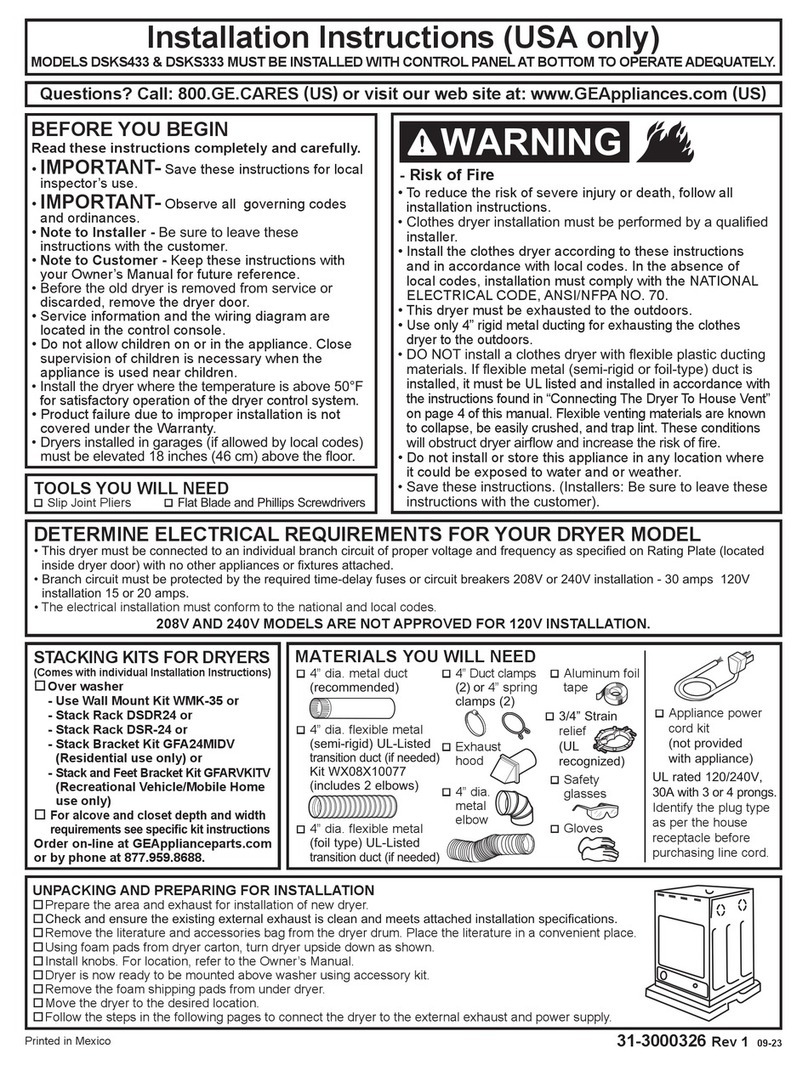
GE
GE DSKS433 installation instructions
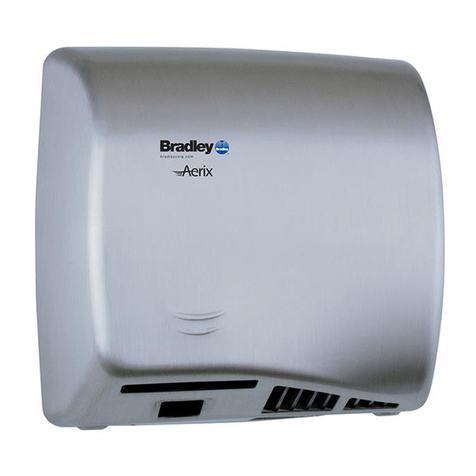
Bradley
Bradley 2902-280000 Bradex Installation and operating manual
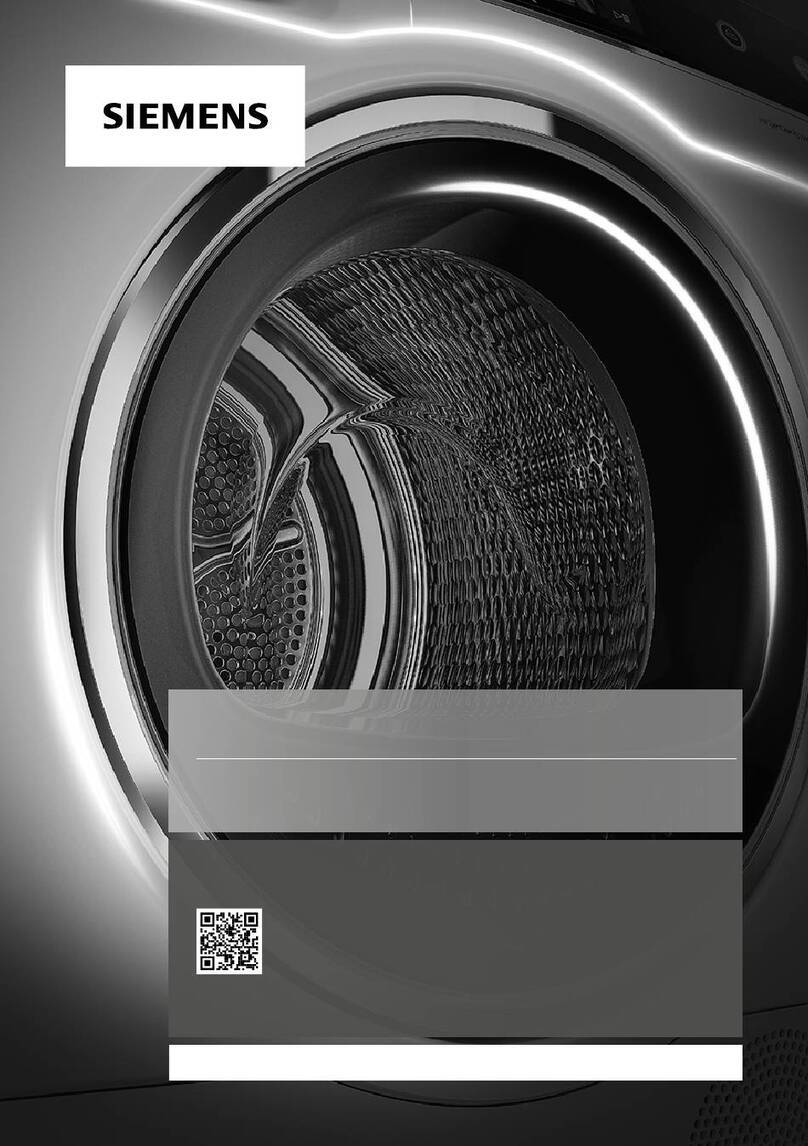
Siemens
Siemens WT47URH00W User manual and installation instructions
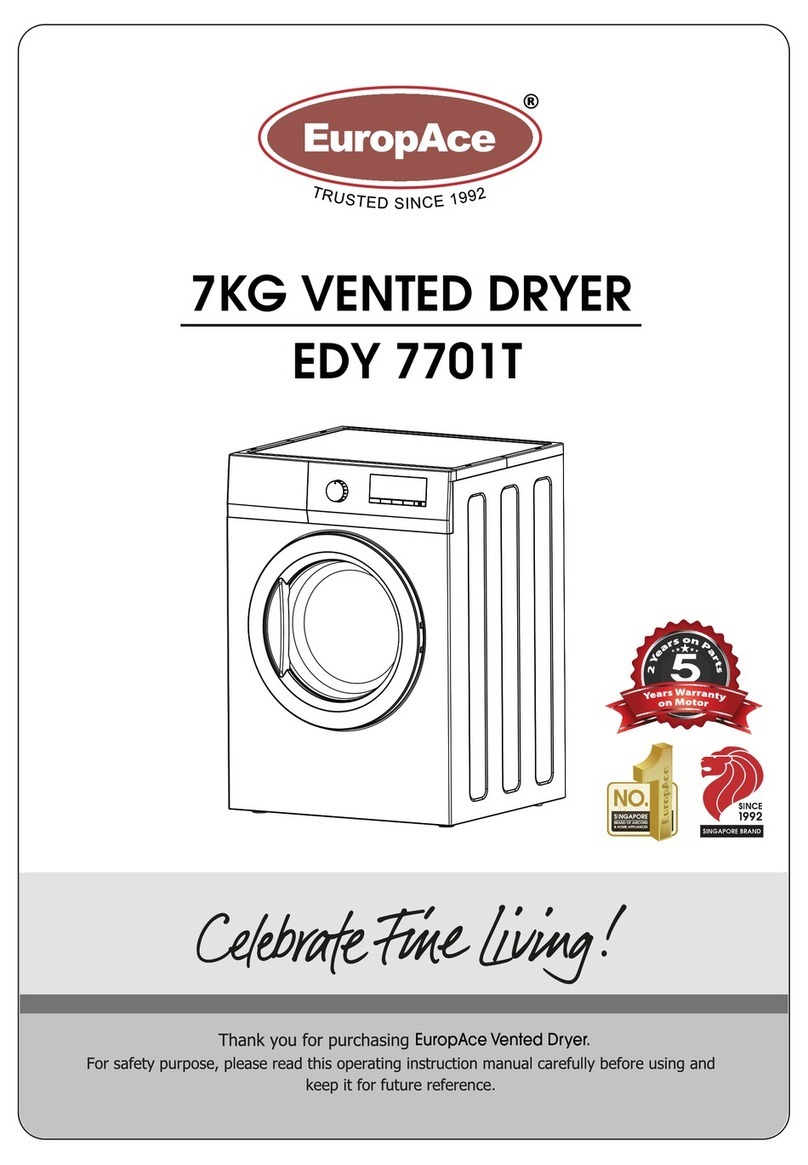
EuropAce
EuropAce EDY 7701T instruction manual
